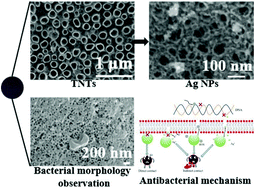Multi-scale hybrid modified coatings on titanium implants for non-cytotoxicity and antibacterial properties†
Abstract
Titanium and its alloys are among the widely used materials in the biomedical field, but they have poor wear resistance and antibacterial properties. In the present study, anodization, photo-reduction, and spin-coating technologies were integrated to prepare a hybrid modified coating for bio-inert titanium implants, having excellent comprehensive performance. The surface roughness of Ti–35Nb–2Ta–3Zr was specifically optimized by surface modification leading to improved wear resistance. Ag ions are still detectable after 28 days of submersion in saline. The antibacterial rate of the composite coating group reaches 100% by plate counting due to the antibacterial mechanism of direct and indirect contact. Both bacteria morphology and fluorescence staining experiments confirm these results. Besides, no cytotoxicity was detected in our fabricated implants during the CCK-8 assay. Accordingly, fabrication of hybrid modified coatings on Ti–35Nb–2Ta–3Zr is an effective strategy for infection and cytotoxicity prevention. These hybrid modified coatings can be regarded as promising multifunctional biomaterials.



 Please wait while we load your content...
Please wait while we load your content...